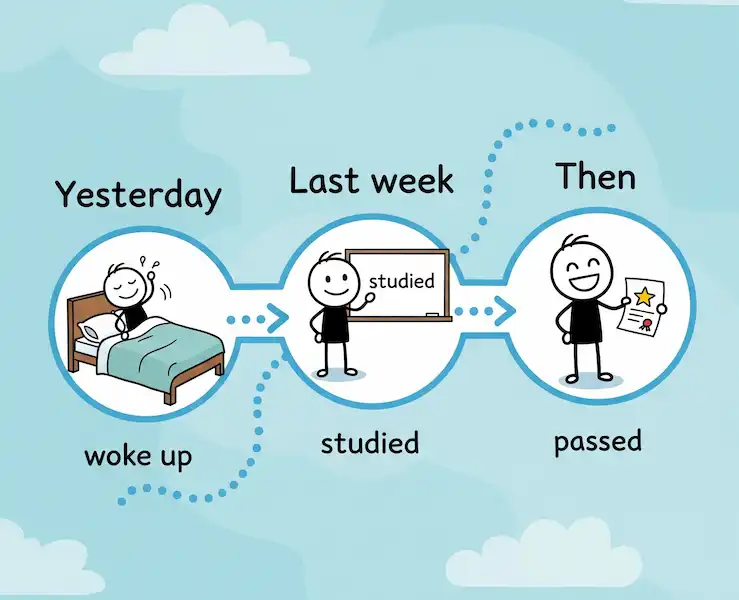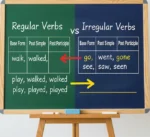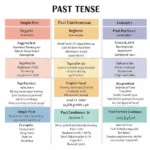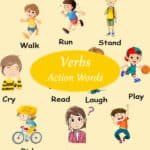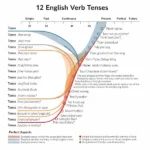Telling a Story with the Simple Past
Hello, future storytellers! ✍️ Do you want to share what you did yesterday, talk about your last holiday, or tell a simple story? The simple past tense storytelling is your best friend for this! It’s the most common way to describe a sequence of events in the past. This article will show you how to use it correctly and confidently.
What is Simple Past Tense Storytelling?
The simple past is a verb tense that shows an action happened and was completed at a specific time in the past.
Example:
- I walked to school yesterday.
- She ate breakfast this morning.
- We watched a movie last night.
We often use time words like yesterday, last week, an hour ago, or in 2020 to show when the action happened.
How to Form the Simple Past
When doing simple past tense storytelling, forming the simple past is easy for most verbs, but there’s a key difference between regular and irregular verbs.
1. Regular Verbs
For regular verbs, we just add -ed to the base form of the verb.
| Base Verb | Simple Past | Example Sentence |
| walk | walked | I walked my dog. |
| play | played | He played soccer. |
| start | started | The movie started at 8 pm. |
| live | lived | They lived in London. |
Spelling Rules for Regular Verbs:
- Verb ends in ‘e’: Just add -d. (e.g., live -> lived)
- Verb ends in ‘consonant + y’: Change ‘y’ to ‘i’ and add -ed. (e.g., study -> studied)
- Verb ends in ‘consonant + vowel + consonant’: Double the final consonant and add -ed. (e.g., stop -> stopped)
2. Irregular Verbs
Irregular verbs don’t follow the -ed rule. They have their own unique forms. You need to memorize these!
| Base Verb | Simple Past | Example Sentence |
| go | went | We went to the beach. |
| eat | ate | She ate a big sandwich. |
| have | had | I had a great time. |
| see | saw | He saw a beautiful bird. |
| do | did | They did their homework. |
A quick note on “be”: The past simple form of “be” is was for I, he, she, it and were for you, we, they.
- I was happy.
- They were at the park.
Simple Past Tense Storytelling – How to Tell a Story: Sequencing Events
When telling a story, we use the simple past to show the order of events. We can also use linking words to connect the sentences and make the story flow better.
Common Linking Words:
- First, then, next, after that, finally: These words help show the order.
Story Example:
My morning was busy. First, I woke up at 6 a.m. and made some coffee. Then, I sent an email to my boss. After that, I ate a quick breakfast and got dressed. Finally, I left for work at 8 o’clock.
Making Negative and Question Sentences
We use the verb did to make questions and negative sentences in the simple past.
Rule: We use did or did not (didn’t) with the base form of the verb (not the past tense form).
| Sentence Type | Structure | Example Sentence |
| Affirmative | Subject + Simple Past Verb | She played tennis. |
| Negative | Subject + did not (didn’t) + Base Verb | She did not play tennis. |
| Question | Did + Subject + Base Verb? | Did she play tennis? |
Example using an irregular verb:
- Affirmative: He went to the store.
- Negative: He didn’t go to the store.
- Question: Did he go to the store?
EAAT Helpful Content
For beginner English learners, using the simple past can feel tricky at first. Here are some tips to help you:
- Focus on a few irregular verbs at a time: Don’t try to memorize all of them at once! Start with common verbs like go, do, have, see, eat, and be.
- Keep a verb list: Write down new verbs you learn and their simple past forms. You can create a simple chart in a notebook.
- Practice with personal stories: The easiest way to practice is to tell a story about your own life. What did you do yesterday? What did you do last weekend?
- Use simple sentences: You don’t need complex grammar to tell a good story. Start with simple sentences and connect them with linking words.
Additional Helpful Content
- Listen to native speakers: Pay attention to how native English speakers use the simple past when they are talking about the past. Notice how often they use “did” and “didn’t.”
- Read simple stories: Reading children’s books or simplified stories is a great way to see the simple past in action.
- Role-play: Practice with a friend or a study partner. Take turns telling a story about your day.
Conclusion
You now have the tools to tell your own stories in English! The simple past tense storytelling is a powerful and essential part of the language. Start with regular verbs, learn the most common irregular verbs, and practice putting events in order. The more you use it, the more natural it will feel. Happy storytelling!
Practice Makes Perfect
Here is a PDF worksheet with a practice paragraph having 25 verbs that need to be changed to the correct past tense form. The answers are on a separate page.
Additional Helpful Content
- Study more about past tense questions – Past Tense Questions: How to Use “Did” & “Didn’t”
- Learn more about using regular and irregular verbs – Regular vs Irregular Verbs: Rules & Lists
- The basics about past tense – Past Tense – Simple, Continuous and Perfect
External Links for Further Learning
- British Council – Simple Past: https://learnenglish.britishcouncil.org/english-grammar/past-simple
- Grammarly Blog – Simple Past: https://www.grammarly.com/blog/past-simple/
- ESL Library – Simple Past: https://esllibrary.com/blog/simple-past-tense-irregular-verbs
